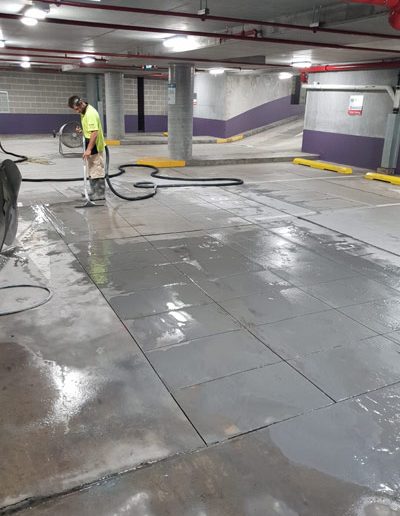Why Knowledge on Proper Disposal of Concrete Slurry is Crucial?
Call Now For an Obligation-FREE Quote
Is proper disposal of concrete slurry necessary? Garbage management is a statutory necessity for any organization that generates waste. If your company yields waste, it must ensure that it manages it effectively and that it follows the waste management hierarchy, which encourages you to reduce, reuse, and recycle your waste before discharging it. Consequently, when operating with concrete, the majority of contractors are compelled to deal with the realities of coping with slurry waste. And so, a question arises. Is concrete slurry considered a toxic waste and does it necessitate specific treatment? Yes, in certain instances — no, in many instances. In fact, the International Grooving and Grinding Association recommends spreading concrete slurry in the space between the curb and the base ditch along roadways under specific conditions. But one thing is indisputable — the subject can be complicated and is governed by various levels of government, including the federal, state, and/or local governments.
Thus, here’s where we unearth why knowledge of the proper disposal of concrete slurry is crucial.
What Is a Concrete Slurry?
Slurry is a potentially hazardous liquid that is produced when abrasive tools are used to polish concrete surfaces while they are wet. While slurry is more than a simple nuisance—it is occasionally used for floor repair, such as sealing air bubbles in concrete surfaces—it is still a hazard to the environment if it is not properly disposed of. Slurry is a substance that is toxic to the environment if it is not properly disposed of.
Why Concrete Slurry Is Harmful to the Environment?
When the disposal of concrete slurry leads into our stormwater systems, a highly toxic environment is created, which has the potential to destroy our delicate aquatic ecosystems. Lime is present in all different kinds of concrete products and is the most important ingredient in cement. When lime from cement dissolves in water, an alkaline solution is produced. This solution is capable of killing organisms such as insects, fish, and plants. Additionally, concrete waste and slurry include hazardous metals with a pH level of approximately 12. The range of pH values that are suitable for the presence of aquatic life is from 6.5 to 9.
Why Is the Disposal of Concrete Slurry a Must?
Before we can practice the disposal of concrete slurry, we must first recognise why it is necessary. The disposal of concrete slurry waste will seem commonplace and useless if you don’t fully comprehend why it is a hazard.
When it comes to efficient disposal of slurry, each state has its own set of standards and regulations to follow. The severe consequences of allowing concrete slurry to be left untreated and disregarded by contractors, on the other hand, are pervasive. First and foremost, when the concrete slurry is allowed to flow downpipes, it erodes the pipes more quickly, resulting in a water blockage or flood. Also, because the concrete slurry is strongly attributable to the water, it will have a detrimental effect on the ocean if it enters the storm drain.
Concrete slurry can be excessively alkaline due to the presence of high pH values. As a result, when combined with the fragile ecology of the ocean, it has the potential to inflict significant harm to aquatic life. It does not matter if there is no storm drain existing and the concrete slurry is allowed to dry—the wind will disperse the slurry particles across the ground and into nearby vegetation, lakes, streams, and the ocean. It has even been seen to mix with the very air we breathe. In what way does it matter whether or not the slurry particles end up in the grass? Watering the lawn or rainfall will still result in runoff containing toxic slurry waste, which will eventually end up in the storm drain.
Implications of Proper Disposal of Concrete Slurry
1. Compliance
The disposal of concrete slurry is a legal necessity for construction businesses alike. All those who manufacture, import or export, convey or deliver, retain or store, process or dispose of concrete slurry wastages are covered by a civil provision.
2. Cost Reduction
Construction waste management is effective in lowering costs in a variety of ways. Thus, this implies the same for the disposal of concrete slurry. Using recycled products will lower your expenditure and eliminate double charges, which relate to paying once for a material that ends up in the trash and then spending again to have it removed from the environment.
3. Increased Awareness Within the Organization
Following the adoption of safe, environmentally friendly waste management techniques at work, such as the proper disposal of concrete slurry, workers may feel obliged to extend these practices to other facets of the business and their personal lives.
4. Greater Dose of Health and Safety
The proper handling and segregation of concrete waste will keep employees and members of the general public safe from mishaps. You’ll eliminate materials from being stored in unsuitable locations by following these steps. For example, they should not be used in areas where they could fall on people or constitute a trip hazard.
5. Fulfilling Social Responsibility
Managing your garbage will assist you in reducing the amount of waste you produce and discard, as well as ensuring that it is correctly handled after it has been taken from your premises. This will aid in the conservation of our planet’s natural resources as well as the reduction of the amount of energy necessary to transfer and recompress waste.
6. Reinforced Reputation
Businesses that demonstrate that they are doing their part to protect the environment will gain a favourable reputation, which will help them enhance their connections with patrons and prospects. It can also assist you in obtaining possibilities with government-funded projects, which frequently demand specific waste management requirements to be met. Now that you have come to a sense of why knowledge of the proper disposal of concrete slurry is crucial, the next feasible thing to take is to do the act. And lucky for you, Advance Cutting provides slurry disposal techniques to make things easier for businesses like yours! We utilize a wet vac to extract the slurry from the surface, which will then be carried to our barrels in our cart. Advance Cutting is concerned about the environment and will always leave the job site nice and clean. If you are planning on doing any projects around your house, it is a good idea to hire a professional for concrete control. You will not only avoid hazardous concrete dust and the risk of illness, but you will also safeguard your local ecosystem from damaging slurry runoff. Thus, you will never go wrong with Advance Cutting. Contact us today! Get a quote by filling out the form below:
Significant Options for the Disposal of Concrete Slurry
Contractors whose projects include cutting or polishing concrete end up with a beautiful product and a disposal problem – concrete slurry. Separators and solidifiers offer two relatively easy ways for the disposal of concrete slurry. Improper removal of concrete slurry will contribute to the reduction of waste and the recycling of water.
The majority of contractors who work with concrete are forced to confront the unavoidable fact of removal of concrete slurry. Due to the obvious potentially hazardous nature of the concrete slurry, it is illegal to flush it down the drain. Working with concrete slurry is becoming increasingly unavoidable as a result of laws issued by the Environmental Protection Agency (EPA) and new proposals for silica dust issued by the Occupational Safety and Health Administration (OSHA). Therefore, with these conditions, what is the righteous procedure for the disposal of concrete slurry? The first option you have is the addition of separators. Separators cause the particulates in the mixture to settle to the bottom and thus enable the water that is left to be recycled or discarded, pending the results of tests to determine whether or not its pH level is acceptable. Another option available to use is the solidifier. With the addition of solidifiers, the liquid mess is transformed into a solid that, in accordance with the regulations of the federal Environmental Protection Agency, is suitable for disposal in landfills, provided that it has been demonstrated that the product does not leave encapsulated pollutants that will leach into groundwater. In general, there are two more methods, but one has a drawback in the form of time, and the other has a drawback in the form of money. Drying the slurry by itself can be effective, but it could take quite some time for the water to evaporate out of the mixture. The slurry can be squeezed to remove water by running it through a press; however, this requires an investment in the necessary machinery. Removal of concrete slurry has emerged as a significant challenge; however, the utilization of equipment such as slurry separators and slurry solidifiers makes the disposal of concrete slurry simple, cost-effective, and productive. Contractors can dispose of the slurry without having to transport it back to the shop first to allow it to dry out naturally. Instead, the slurry can be disposed of directly at the job site.
Disposal of Concrete Slurry: Things You Should Know
According to the Resource Management Act 1991, it is against the law to dump any substance into natural water, stormwater systems, or the land itself. Abatement notices, fines of up to $60,000, and even criminal prosecution are possible outcomes that can follow from improper disposal of concrete slurry into drains or onto land. Bearing this, what should you know then?
Hire a Pro.
To ensure proper disposal of concrete slurry, it is best to hire a professional. A significant monetary penalty may be incurred as a result of your improper management of the waste.
Do not dispose of concrete slurry down the drain.
It is important to refrain from pouring any concrete waste or slurry into the drainage systems. This activity is harmful to our environment because all of the drains eventually empty into our oceans and can be harmful to marine life.
Do not make any attempt to dilute concrete slurry.
Under no circumstances should you attempt to dilute concrete waste or slurry. To dilute just one bucket requires more than one hundred thousand litres of potable water. For the sake of proper disposal of concrete slurry, it is strongly recommended to consult with an experienced specialist.
Do not allow the discarded concrete slurry to harden.
If you’ve waited until the last minute to organise how your concrete waste will be disposed of, consider sweeping or shovelling the slurry into a pile so that it can be disposed of. Don’t wait until the last minute or it will be too late.
Disposal of Concrete Slurry: A Management Guide and Disposal Plan
Now that you are aware of the possible dangers posed by slurry, let’s examine the ways in which it might be managed and disposed of in an appropriate manner.
- Have a written plan for the best management practices in place.
- It is important to be familiar with the requirements of the EPA as well as any state and municipal laws that may also apply to the disposal.
- Carry out a preliminary analysis to assist in determining whether or not the concrete may contain any hazardous contaminants.
- Determine the method by which the slurry will be collected and then stored.
- If you have reason to believe that the concrete includes contaminants, you should have it tested.
- Carry out pH testing at predetermined time intervals.
- Prepare yourself for the possibility of inadvertent spills or leaks.
- Comply with EPA, state, and/or local regulations for disposal.
Get in touch
76 Railway St Yennora, NSW, 2161
0411 835 900
accounts@advancecutting.com.au
Follow Us


